(Continued from Vol. 2, No. 18, 1955, p. 563–69)
Further observations were made of the ogives on MorsárjökullReference Ives and King 6 and those on Svínafellsjökull were also examined during 1954. Skaftafellsjökull does not appear to have any ogives, probably because its gradient is not nearly so steep as that of the other two glaciers. Reference to the ogives of Falljökull will be made briefly. These glaciers are shown in Fig. 1 (Part 1, p. 564).
Although ogives form under both the connected ice fall and the avalanche fans of Morsárjökull on the north-west and south-east branches respectively, they are not equally distinct on the glacier surface. The ogives are very much more distinct below the avalanche fans, so that observations on this side of the glacier were more extensive than those on the other side. In 1953 a cairn was left on the glacier between the 7th and 8th ogives from the head of the glacier; this cairn was located in 1954 and the number of ogives above it was 8, so that it was now between the 8th and 9th ogives. This is good evidence that one ogive forms each year. The distance apart of the first 8 ogives was measured by tape and the dip at their apices was measured by clinometer. The following results were obtained:
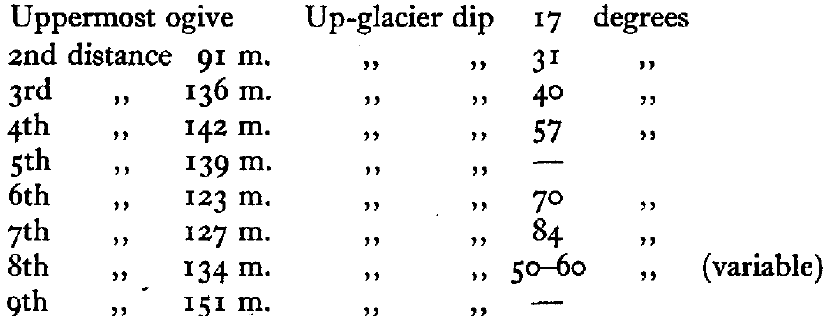
The distance apart of the ogives is on the average a little greater than the annual movement, which is about 108.5 m. This may represent the amount by which the glacier has slowed down in the last few years as it has become increasingly thinReference Ahlmann 7 . If the dip of the ogive becomes less at depth, ablation will also have the affect of increasing the apparent distance apart of the ogives further down-glacier. The figures also show that the up-glacier dip of the ogives increases down-glacier. The dark bands of the ogives are mostly less than 3 m. in width. Their dip was measured on the edges of crevasses, where they can be seen to dip down into the glacier (see Figs. 8 and 9, p. 651).
The character of the avalanche fans was examined near their base where the upper ogives form. Towards the base of the avalanche fans the dip of the incipient ogives becomes irregular. Further up, in the lower part of the avalanche material, the new avalanche debris overlies the older material with a gentle down-glacier dip of about 20 degrees. The older summer avalanche material was very dirty; it incorporated much fine debris as well as larger, rounded stones up to about 15 cm. in diameter. Near the edge of the glacier, at the lower end of the avalanche fans, large U-shaped crevasses, separated by smooth ridges, had formed (see Fig. 9).
On the north-west part of the glacier the ogives could not be located and measured. Close under the connected ice fall there are marked ridges of ice, these are fairly level buthave a steep slope down-glacier. The ice appears to be coarsely crystalline with thin blue layers about 0.5 cm. thick. These layers appear to be those called “tectonic blue bands” according to the terminology suggested in the Journal of Glaciology 8 . These bands give a layering to the ice which is nearly vertical throughout the upper part of the glacier, dipping 80–90 degrees up-glacier. The strike of the blue layers runs parallel to the foot of the ice-fall.
The ogives on Svínafellsjökull show several features of interest. The distance apart of the dark bands were measured by tape near the site of the flow observations (see Fig. 4, p. 649). The bands could be distinguished fairly clearly from the top of the trim-line so that measurements were directed from there. The dark bands in this area averaged 35 m. apart. These bands could be seen on a photograph (Fig. 10, p. 651) taken a little further down-glacier and their distance apart could be compared with larger ogives also visible on the photograph but in an area too crevassed for direct measurement. The larger ogives were five times the distance apart of the smaller ones, that is, 175 m. apart. It is significant that the annual movement of the glacier in the same vicinity is 172.5 m. The larger ogives are therefore clearly annual in character, but the more conspicuous smaller ones are not.
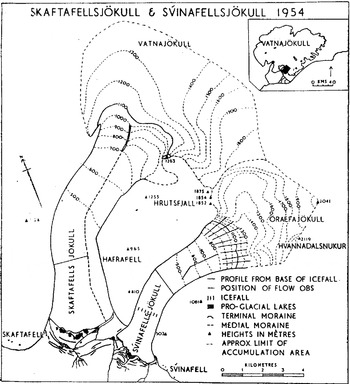
Fig. 4 (repeated from Part I)
Svínafellsjökull is fed from the high volcanic dome of Öraefajökull via a steep ice fall about 500 m. high. The area at the base of the ice fall was examined and a profile surveyed for a distance of 2300 m. by altimeter; the profile is shown in Fig. 7 (p. 649). It shows a series of ridges below the ice fall; these were of smooth ice with large transverse crevasses (Fig. 11, p. 651). In the troughs dirty snow was found near the foot of the ice fall. The ice was similar to that under the ice fall of Morsárjökull, being coarsely crystalline with thin “tectonic blue bands”. These bands were nearly vertical or had very steep up-glacier dips throughout the area examined from the flow stakes to the foot of the ice fall. The distance apart of the crests of the ridges under the ice fall do not correlate with either the distance apart of the smaller ogives or the larger annual ones. They are somewhat irregular in spacing and height but gradually die out down-glacier till the surface of the glacier is nearly flat and little crevassed.
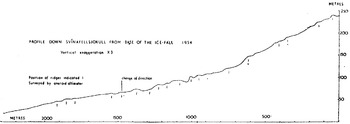
Fig. 7
Ogives were also found on Falljökull, a very steep glacier draining from Öraefajökull (shown in Fig. 1, Part 1, p. 564). Their spacing was clearly much too close for them to correlate with the annual movement of the glacier so that they are probably similar in origin to the closer ogives on Svínafellsjökull. The distance apart of the ogives was measured by pacing, giving the approximate distance between successive ogives in metres as follows: 22, 40, 27, 18, 5.5, 21, 48, 35. The bands were distorted, faulted and fractured and sometimes bifurcated.
One of the problems raised by these observations is to account for the occurrence of non-annual as well as annual ogives in the same glacier at the same time.
A theory to explain the formation of ogives must take into account at least four different features; the annual ogive, the smaller feature of a similar type, the tectonic blue bands which are found throughout the glacier and the ridges which only occur beneath the ice falls where the gradient flattens.
The crevasse pattern suggests possibilities concerning the type of ice-flow according to the work of NyeReference Nye 9 . Under the ice falls and for some distance down-glacier the crevasse pattern suggests a zone of compressive flow, which may be associated with thrust planes within the ice. This type of crevasse pattern is found on Morsárjökull, Falljökull and Svinafellsjökull. Lower down on Svínafellsjökull the crevasse pattern suggests extending flow while between the two zones the ice is very flat with few crevasses. This should indicate that the bed of the glacier is longitudinally concave below the ice fall but, on Svinafellsjökull at least, becomes convex lower down. There is also a small area of extending flow suggested on the north-west side of Morsárjökull a short distance below the connected ice fall; this may point to the lip of a rock-basin further up-glacier, beneath the ice fall.
The significance of the crevasse pattern and associated type of glacier flow, with regard to the development of ogives, lies in the possibility of thrust zones, along which material can move up from the base of the glacier, below the ice falls and avalanche fans. This would account for the three-dimensional nature of the ogives.
Little dirt appears to reach the surface of Svínafellsjökull along such possible zones of thrusting except perhaps at the edge of the glacier (Fig. 10), where the ogives are more conspicuous. The upper dark bands of the ogives on the south-east part of Morsárjökull show a considerable concentration of fine dirt and numerous larger rounded stones are also present (Fig. 8). Dirt and boulders beneath the connected ice fall of Morsárjökull may reach the glacier surface from the bed because pink agglomerate blocks are found which do not appear to have come from the exposed valley walls. These blocks are numerous and large on one part of the glacier.
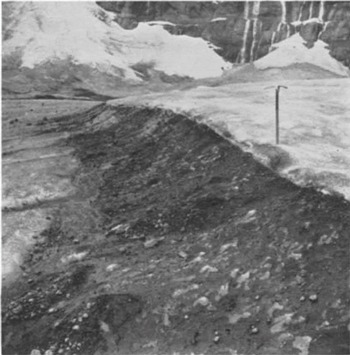
Fig. 8 A close-up view of the dark band of one of the upper ogives beneath the avalanche fans of the south-east side of ,llorsdrjikull. The concentration of dirt crud the rounded stones are conspicuous. The clean cut upper edge of the band tan be seen
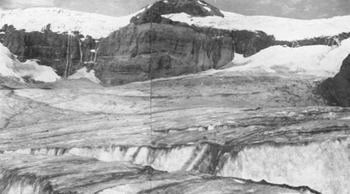
Fig. 9 The ogives of the upper part of the south-east side of Morsdrjrkull can be seen below the avalanche fans. One of these is exposed in the crevasses on the lower right, while the large U-shaped crevasses beneath the avalanche fans tan be seen near the rock-wall on the right
One of the main problems arising from the observations on Svínafellsjökull is to establish the connexion between the ridges beneath the ice fall and the ogives. The distance apart of the ridges is not very even and does not correlate with the distance apart of the annual ogives (175 m.) or the smaller ogives (35 m.) as shown on Fig. 10. The ridges are 82 m. apart on the average where they are best developed. There is a tendency for every fifth ridge to be larger than the intermediate ones where these are largest. If the ridges and ogives are connected, the smaller distance between ogives could be accounted for by the slowing up of the glacier flow where the surface slope of the ice becomes much less steep below the ice fall; here the ridges die out and the ogives start.
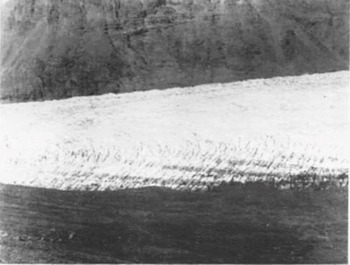
Fig. 10 Svinafellsjökull showing on the right in the centre of the glacier the small ogives.35 m apart and on the left the annual ogives, 175 in apart
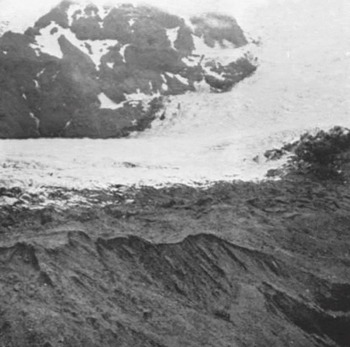
Fig. 11 (top right). The ice fall of Svinafellsjákull showing the ridges belot, it against the hillside on the far side of the glacier
The flow of the glacier is in some way responsible for the formation of the ridges and the ogives, and the fact that both occur beneath connected ice falls suggests that the features are related. It is known that glacier flow is not continuous and steady from the work of many glaciologists of which the BattleReference Battle 10 and HaefeliReference Haefeli 11 may be cited as examples, and from the observations made on the flow of Morsárjökull in 1953 and 1954 (see ref. 2, Part 1, p. 569). This irregularity of flow is probably related to variations in the supply of ice, via the ice fall or avalanche fans in this instance.
The irregularity of flow may be of different orders; on a small scale the glacier may move in jerks rather than continuously, while on a larger scale periodic or seasonal surges of flow may occur when the increased pressure resulting from greater supply overcomes the strength of the ice. Orowan 12 has calculated that the increase of rate of flow changes very rapidly with change of stress. He considers that the glacier flow increases by about roo per cent for an increase of weight of 1 per cent by the winter snowfall.
Short period movement may result in the formation of the “tectonic blue bands” already mentioned, by differential movement of thin layers of ice as described by DemorestReference Demorest 13 . The smaller ogives may represent an intermediate type of movement, the size and spacing of the band depending on the character of the glacier. The movement of ice down the ice fall may lead to a thickening of the glacier at the base which will continue until the stress is greater than the strength of the ice. This would allow rapid movement and the formation of a ridge at the base of the ice fall; the pressure would be released and the flow would again fall off.
The conditions of Svínafellsjökull seem to be such that five ridges form each year which may be converted into true ogives down glacier. The annual ogive may be formed in a similar way, but seasonal factors are significant in its genesis. The winter snowfall reaches a maximum in February and March, while the glacier is coldest and driest about the same period and therefore probably strongest. This allows a considerable build-up of pressure in the ice fall. With the increasing warmth and water in the glacier this may lead to a correspondingly great surge, resulting in the formation of a larger ridge. This may subsequently become an annual ogive, lower down the glacier, as ablation reveals lower layers and differential movement in cross-section accentuates the ogive form.
The ice fall of Falljökull appears to be more unstable and less regular in its movement than that of Svínafellsjökull, so that the formation of ogives is less regular and those that do form are cut by faulting and shearing near the snout of the glacier.
The formation of ogives has been shown to be an annual occurrence on both Morsárjökull and Svínafellsjökull, but similar features are formed on the latter glacier and on Falljökull at a shorter time interval also. Many problems remain to be solved concerning these interesting features.










